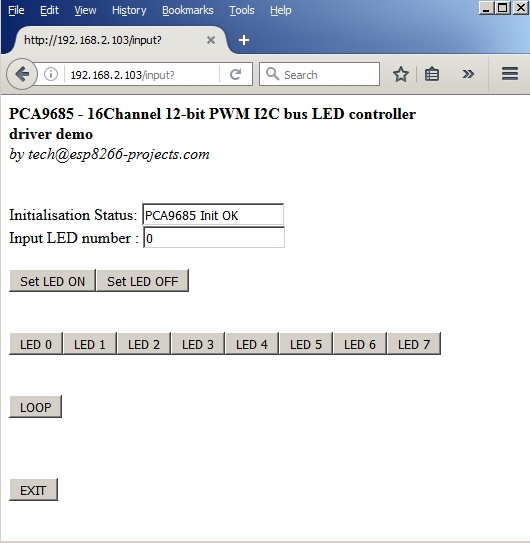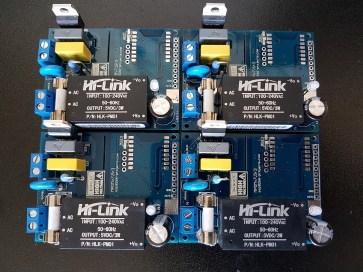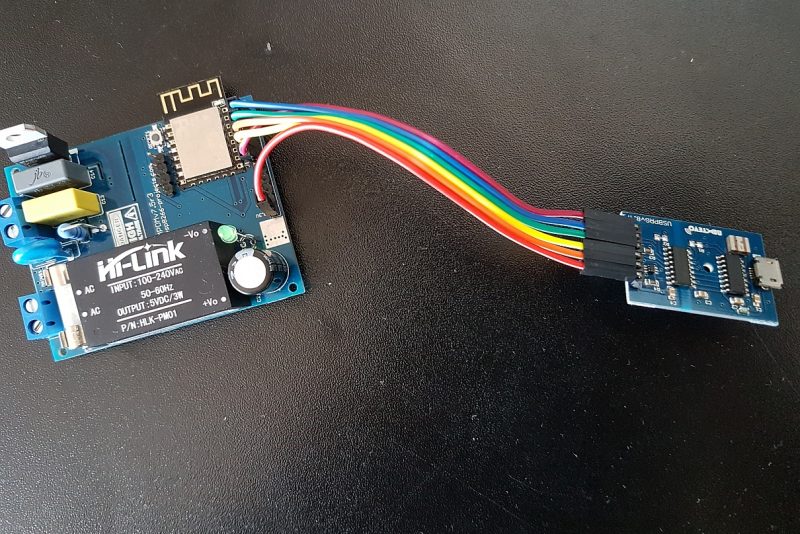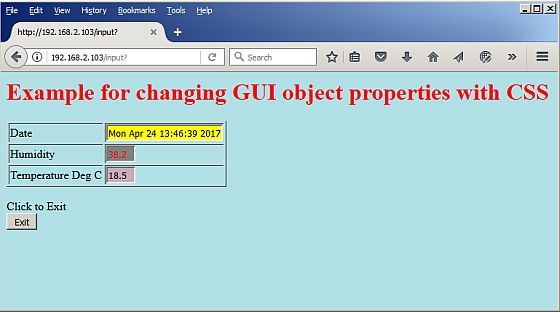PCA9685 Extension Board Module Available also on Tindie!
ESP Basic Tutorials Series: PCA9685-16Channel 12-bit PWM I²C-bus LED controller Driver – Part 1
If you are looking for a very simple to use 16 Channel LED controller or just for a nice 16 Channel, high resolution PWM driver then this one is for you!
The PCA9685 is an I²C-bus controlled 16-channel LED controller optimized for Red/Green/Blue/Amber (RGBA) color backlighting applications.
What we will need:
- ESP8266 nEXT EVO Board ( Bare PCB available directly at DirtyPCB’s Shop )
- PCA9685 Extension Board Module like the one from here.
- For programming and uploading the driver and the software we will use the ESPBasic
Connection with the ESP8266 nEXT EVO Board is very easy, as PCA9685 Module connector is fully compatible with the nEXT Bus connector.
Driver implementation
As been a I2C compatible device you need to have a standard I2C Bus Initialisation function as usual and also to know the I2C address of the device.
For a more detailed hardware overview go to PCA9685 General Description Article.
Software:
1. Main program:
i2c.setup(4,5) 'choose your I2C bus pins dev_addr = 64 '0x40 - I2C Address for the PCA9685 mode1 = 0 '0x00 location for Mode1 register address mode2 = 1 '0x01 location for Mode2 reigster address led0 = 6 '0x06 location for start of LED0 registers rst = 1 '0x01 reset device rval = 0 'read register value led_on = 4096 led_off = 0 ledN = 0 dim led_stat(8) led_stat(0)=0 led_stat(1)=0 led_stat(2)=0 led_stat(3)=0 led_stat(4)=0 led_stat(5)=0 led_stat(6)=0 led_stat(7)=0 stat = "Init.." 'reset device write_reg(mode1, rst) reg = mode1 data = rst gosub [WRITE_REG] 'check if proper initialised gosub [READ_REG] 'wprint rval if rval == "1" then status = true stat = "PCA9685 Init OK" else status = false stat = "PCA9685 Init Failure!" end if wprint " <b>PCA9685 - 16Channel 12-bit PWM I2C bus LED controller<br>driver demo</b><br><i>by tech@esp8266-projects.com</i><br><br><br>" wprint "Initialisation Status: " textbox stat 'set for auto-increment let data = 160 gosub [WRITE_REG] 'Choose below the desired output mode! 'Direct LED connection 'set to output mode INVRT = 1 OUTDRV = 0 reg = mode2 data = 16 gosub [WRITE_REG] 'External N-type driver 'write_reg(mode2, 0x04) -- set to output mode INVRT = 0 OUTDRV = 1 'External P-type driver 'write_reg(mode2, 0x14) --set to output mode INVRT = 1 OUTDRV = 1 'choose LED_N - ON wprint " <br>Input LED number : " textbox ledN wprint "<br> <br>" button " Set LED ON ",[SetON] button " Set LED OFF ",[SetOFF] wprint "<br> <br> <br>" button "LED 0",[LED0] button "LED 1",[LED1] button "LED 2",[LED2] button "LED 3",[LED3] button "LED 4",[LED4] button "LED 5",[LED5] button "LED 6",[LED6] button "LED 7",[LED7] wprint "<br> <br><br>" button "LOOP",[loop] wprint "<br> <br><br> <br>" button "EXIT",[Exit] wait
2. LOW Level subroutines
2.1 WRITE Register “reg”
[WRITE_REG] i2c.begin(dev_addr) i2c.write(reg) i2c.write(data) i2c.end() return
2.2 READ Register “reg”
[READ_REG] i2c.begin(dev_addr) i2c.write(reg) i2c.end() i2c.begin(dev_addr) i2c.requestfrom(dev_addr,1) 'start a transaction to read 1 byte rval = i2c.read() 'read the byte i2c.end() return
2.3 WRITE LED_N Register
[WRITE_LED] i2c.begin(dev_addr) i2c.write(led0+4*ledN) ah = led_on >> 8 al = led_on and 255 i2c.write(al) i2c.write(ah) ah = led_off >> 8 al = led_off and 255 i2c.write(al) i2c.write(ah) i2c.end() return
3. BUTTON Subroutines
[LED0] ledN = 0 gosub [LED_SW] wait [LED1] ledN = 1 gosub [LED_SW] wait [LED2] ledN = 2 gosub [LED_SW] wait [LED3] ledN = 3 gosub [LED_SW] wait [LED4] ledN = 4 gosub [LED_SW] wait [LED5] ledN = 5 gosub [LED_SW] wait [LED6] ledN = 6 gosub [LED_SW] wait [LED7] ledN = 7 gosub [LED_SW] wait
4. LED_N Switch subroutine
[LED_SW] if led_stat(ledN) = 0 then led_stat(ledN) = 1 led_on = 4096 led_off = 0 gosub [WRITE_LED] else led_stat(ledN) = 0 led_on = 0 led_off = 4096 gosub [WRITE_LED] end if return
5. ON / OFF Subroutines
[SetON] led_on = 4096 led_off = 0 gosub [WRITE_LED] wait [SetOFF] led_on = 0 led_off = 4096 gosub [WRITE_LED] wait
6. FOR loop demo
[loop] For x = 0 to 8 ledN = x gosub [LED_SW] Next x For x = 8 to 0 step -1 ledN = x gosub [LED_SW] Next x wait
7. EXIT Program subroutine
[Exit] end
In the ESP Basic Web editor interface Type & Save your program as “PCA9685.bas” and Run it.
If all OK the result should look as below:



